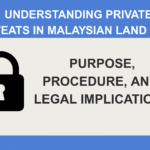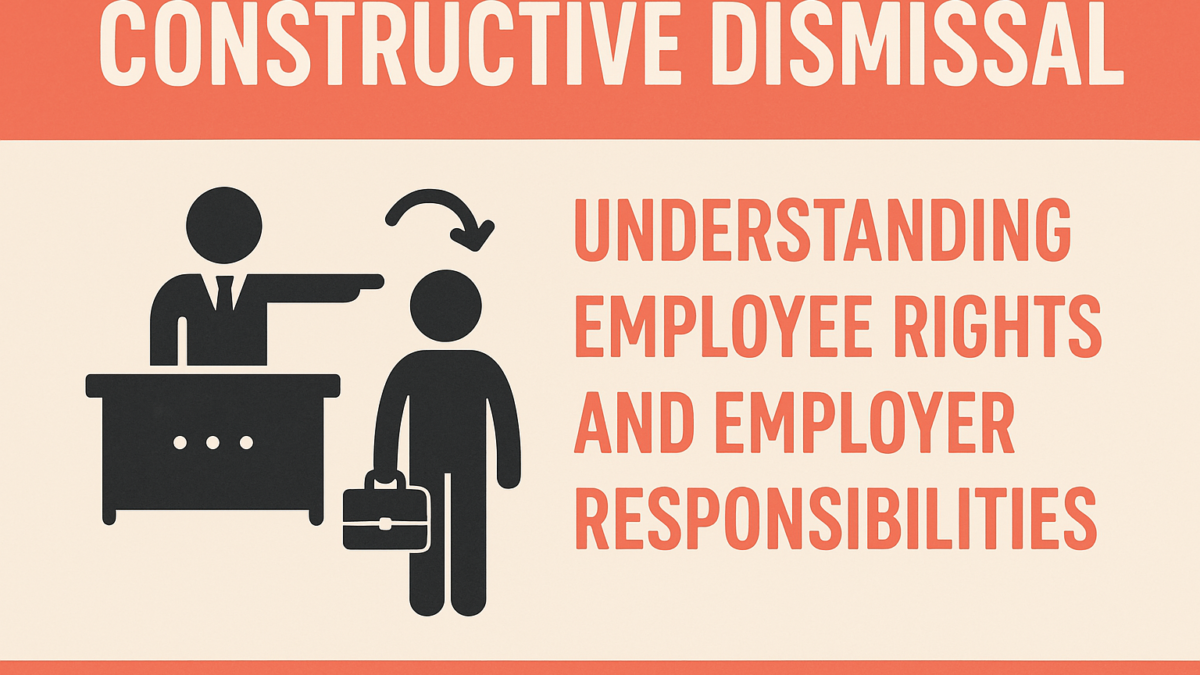
Understanding Private Caveats in Malaysian Land Law: Purpose, Procedure, and Legal Implications
May 22, 2025By: Shahrizal Mizani Bin Abd Khamis
Constructive dismissal is a critical concept in employment law that affects both employees and employers. It occurs when an employee is forced to resign due to the employer’s fundamental breach of contract, making continued employment untenable. Unlike traditional dismissal, where the employer explicitly terminates the employee’s contract, constructive dismissal arises from indirect actions that compel an employee to leave. This principle was affirmed in Bayer (M) Sdn. Bhd. v Anwar Abd. Rahim [1996] 2 CLJ 49, where the court held that the appropriate test for constructive dismissal is the contract test, not the reasonableness test. The employee must prove that the employer committed a fundamental breach of contract or indicated an unwillingness to be bound by it.
Under Malaysian law, Section 20 of the Industrial Relations Act 1967 provides employees with the right to challenge an unfair dismissal by filing a representation to the Director-General of the Industrial Relations Department. However, the Act does not explicitly define dismissal or constructive dismissal, leaving it to case law to establish guiding principles. In Southern Investment Bank/Southern Bank & Anor v Yap Fat & Anor [2017] 8 CLJ 159, the court ruled that constructive dismissal arises when an employee resigns due to the employer’s violation of fundamental terms of the employment contract, undermining the very foundation of the agreement.
Various employer actions can constitute constructive dismissal. These include unjustified demotion, arbitrary salary deductions, unpaid wages or bonuses, breaches of confidentiality, and unfair or unreasonable transfer orders that adversely affect an employee’s status. In Govindasamy Munusamy v Industrial Court Malaysia & Anor [2007] 10 CLJ 266, the High Court ruled that an employer must be given reasonable notice to rectify the breach before an employee can claim constructive dismissal. If the breach remains unresolved, the employee has the right to terminate their employment immediately.
However, not all workplace grievances amount to constructive dismissal. In Tan Cheng Hin v Federal Metal Printing Sdn. Bhd. [1999] 3 MLJ 564, the court held that if a transfer clause exists in an employment contract, an employer’s decision to transfer an employee will not constitute constructive dismissal. Similarly, in Chua Yeow Cher v Tele Dynamics Sdn. Bhd. [2000] 1 MLJ 168, the court ruled that a transfer that does not lead to reduced earnings does not breach the contract. Additionally, in Habibah bte Mohd Zainan v Pan Global Insurance Bhd. [2001] 6 MLJ 339, the court affirmed that significant reductions in job responsibilities due to transfer may justify a constructive dismissal claim.
The burden of proof in constructive dismissal claims falls on the employee, as emphasized in CIMB Bank Bhd v Ahmad Suhairi Mat Ali & Anor [2023] 4 ILR 1. The employee must demonstrate that the employer repudiated an essential term of the employment contract. This principle was reinforced in Moo Ng v Kiwi Products Sdn Bhd [1998] 3 CLJ 475, establishing that mere dissatisfaction with workplace conditions is insufficient. The claim must satisfy the four key conditions outlined in Western Excavating (EEC) Ltd. V Sharp [1978] 1 All ER 713. Firstly, there must be a fundamental breach of contract by the employer. Next, the breach must be severe enough to justify the employee’s resignation. Additionally, the resignation must be directly linked to the breach. Lastly, the resignation must occur within a reasonable timeframe to maintain its validity.
Employers should exercise caution when implementing changes that could impact employees' contractual rights. While management prerogatives, such as transfers, are recognized in industrial law, they must be carried out fairly and in good faith. The case of Soon Seng Cement Products Sdn Bhd & Anor v Non-Metallic Mineral Products Manufacturing Employees' Union [1996] 1 ILR 414 emphasized that transfers must adhere to five key principles. Firstly, they must not contradict employment terms. Next, they must be made in good faith for business purposes. Additionally, they must not be driven by malice or hidden agendas. Furthermore, they must not be intended to harass or victimize the employee. Lastly, they must not fundamentally alter the employee’s service conditions. If an employer violates these principles, the Industrial Court may intervene and rule the action unlawful.
A 2020 study by Yusof, Abdul Rahim, and Kamarudin analysed Malaysian Industrial Court decisions on constructive dismissal from 1995 to 2004, finding that only 43.7% of cases favoured employees, while 56.3% favoured employers. The most cited reasons for claims were work-related issues (28%), while demotions accounted for only 3.2%. This data underscores the importance of presenting strong, legally grounded evidence when pursuing a constructive dismissal claim.
For employees, it is crucial to document incidents thoroughly and seek legal advice before resigning due to workplace disputes. A premature resignation may weaken the claim. Employers, on the other hand, must ensure fair treatment and clear communication in managing workplace issues. By fostering a fair and transparent work environment, both employees and employers can mitigate disputes and uphold workplace integrity.
References:
Section 20 of the Industrial Relations Act 1967 (Act 177)
Bayer (M) Sdn. Bhd. v Anwar Abd. Rahim [1996] 2 CLJ 49
Chua Yeow Cher v Tele Dynamics Sdn. Bhd. [2000] 1 MLJ 168
CIMB Bank Bhd v Ahmad Suhairi Mat Ali & Anor [2023] 4 ILR 1
Govindasamy Munusamy v Industrial Court Malaysia & Anor [2007] 10 CLJ 266
Habibah bte Mohd Zainan v Pan Global Insurance Bhd. [2001] 6 MLJ 339
Moo Ng v Kiwi Products Sdn Bhd [1998] 3 CLJ 475
Soon Seng Cement Products Sdn Bhd & Anor v Non-Metallic Mineral Products Manufacturing Employees' Union [1996] 1 ILR 414
Southern Investment Bank/Southern Bank & Anor v Yap Fat & Anor [2017] 8 CLJ 159
Tan Cheng Hin v Federal Metal Printing Sdn. Bhd. [1999] 3 MLJ 564
Western Excavating (EEC) Ltd. v Sharp [1978] 1 All ER 713
Yusof, R. M., Abdul Rahim, A. R., & Kamarudin, S. (2020). Constructive dismissal: Lessons learnt from Malaysian Industrial Court cases. International Journal of Academic Research in Business and Social Sciences, 10(11), 469-485.
Disclaimer
The information provided in this article is for general informational purposes only and does not constitute legal advice. While effort has been made to ensure the accuracy of the content at the time of publication, laws and regulations may change, and interpretations may vary.
Neither the author nor the publisher assumes any responsibility for any errors, omissions, or any outcomes related to the use of this information. You are strongly encouraged to seek professional legal advice or verify the applicable laws with a qualified legal practitioner.
By reading this article, you acknowledge and agree that the author and publisher shall not be held liable for any reliance placed on the information provided.
